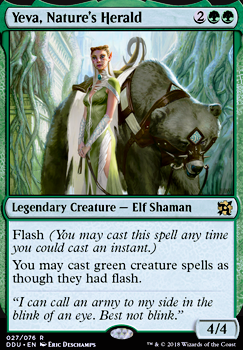
The Cat and the Muse (Yeva, Nature's Herald)
Commander / EDH Casual Goodstuff Mono-Green Multiplayer Value Engine
Creature (40)
- 1x Acidic Slime
- 1x Arbor Elf
- 1x Avenger of Zendikar
- 1x Bane of Progress
-
1x
Beast Whisperer

- 1x Brutalizer Exarch
- 1x Caustic Caterpillar
- 1x Craterhoof Behemoth
- 1x Destiny Spinner
- 1x Elvish Mystic
- 1x Elvish Visionary
- 1x Eternal Witness
- 1x Fauna Shaman
- 1x Fierce Empath
- 1x Garruk's Packleader
- 1x Genesis
- 1x Ghalta, Primal Hunger
- 1x Invasive Species
- 1x Karametra's Acolyte
- 1x Krosan Tusker
- 1x Llanowar Elves
- 1x Loaming Shaman
- 1x Manglehorn
- 1x Reclamation Sage
- 1x Regal Force
- 1x Seedborn Muse
- 1x Selvala, Heart of the Wilds
- 1x Shaman of Forgotten Ways
- 1x Soul of the Harvest
- 1x Spore Frog
- 1x Temur Sabertooth
- 1x Tendershoot Dryad
- 1x Terastodon
- 1x Timbermare
- 1x Ulvenwald Tracker
- 1x Whisperer of the Wilds
- 1x Wirewood Symbiote
- 1x Wood Elves
- 1x Woodland Bellower
- 1x Yavimaya Dryad
Sorcery (9)
- 1x Creeping Renaissance
- 1x Eldritch Evolution
- 1x Finale of Devastation
- 1x Green Sun's Zenith
- 1x Harmonize
- 1x Overwhelming Stampede
- 1x Rishkar's Expertise
- 1x Shamanic Revelation
- 1x Uncage the Menagerie
Enchantment (8)
- 1x Awakening
- 1x Elemental Bond
- 1x Greater Good
-
1x
Growing Rites of Itlimoc
 Flip
Flip
- 1x Guardian Project
- 1x Kenrith's Transformation
- 1x Lignify
- 1x Nature's Will
Artifact (2)
Commander (1)
Instant (4)
Land (36)
Sideboard
Suggestions
Updates Add
Comments
Attention! Complete Comment Tutorial! This annoying message will go away once you do!
Important! Formatting tips — Comment Tutorial — markdown syntax
Please login to comment
94% Casual
Competitive
| Date added | 4 years |
| Last updated | 3 years |
| Exclude colors | WUBR |
| Key combos | |
| Legality | This deck is Commander / EDH legal. |
| Rarity (main - side) | 7 - 0 Mythic Rares 28 - 1 Rares 17 - 0 Uncommons 15 - 0 Commons |
| Cards | 100 |
| Avg. CMC | 3.67 |
| Tokens | Beast 3/3 G, City's Blessing, Elephant 3-3 G, Plant 0/1 G, Saproling 1/1 G |
| Votes | |
| Ignored suggestions | |
| Shared with | |
| Views |

